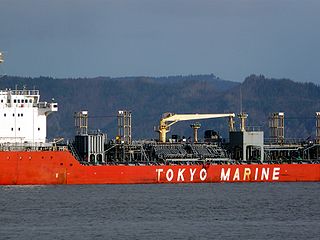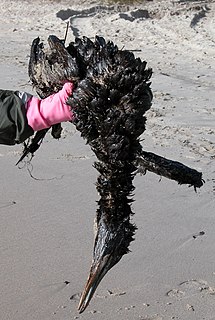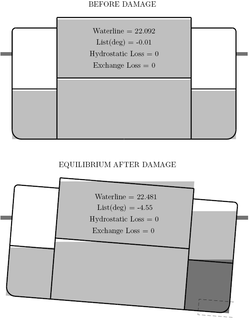A double-hulled tanker refers to an oil tanker which has a double hull. They reduce the likelihood of leaks occurring compared to single-hulled tankers, and their ability to prevent or reduce oil spills led to double hulls being standardized for oil tankers and other types of ships including by the International Convention for the Prevention of Pollution from Ships or MARPOL Convention. After the Exxon Valdez oil spill disaster in Alaska in 1989, the US Government required all new oil tankers built for use between US ports to be equipped with a full double hull.

The Exxon Valdez oil spill occurred in Prince William Sound, Alaska, March 24, 1989, when Exxon Valdez, an oil tanker owned by Exxon Shipping Company, bound for Long Beach, California, struck Prince William Sound's Bligh Reef, 1.5 mi (2.4 km) west of Tatitlek, Alaska, at 12:04 am. local time and spilled 10.8 million US gallons (260,000 bbl) of crude oil over the next few days. It is considered to be one of the worst human-caused environmental disasters. The Valdez spill is the second largest in US waters, after the 2010 Deepwater Horizon oil spill, in terms of volume released. Prince William Sound's remote location, accessible only by helicopter, plane, or boat, made government and industry response efforts difficult and severely taxed existing response plans. The region is a habitat for salmon, sea otters, seals and seabirds. The oil, originally extracted at the Prudhoe Bay Oil Field, eventually impacted 1,300 miles (2,100 km) of coastline, of which 200 miles (320 km) were heavily or moderately oiled with an obvious impact.

An oil spill is the release of a liquid petroleum hydrocarbon into the environment, especially the marine ecosystem, due to human activity, and is a form of pollution. The term is usually given to marine oil spills, where oil is released into the ocean or coastal waters, but spills may also occur on land. Oil spills may be due to releases of crude oil from tankers, offshore platforms, drilling rigs and wells, as well as spills of refined petroleum products and their by-products, heavier fuels used by large ships such as bunker fuel, or the spill of any oily refuse or waste oil.

Oriental Nicety, formerly Exxon Valdez, Exxon Mediterranean, SeaRiver Mediterranean, S/R Mediterranean, Mediterranean, and Dong Fang Ocean, was an oil tanker that gained notoriety after running aground in Prince William Sound spilling hundreds of thousands of barrels of crude oil in Alaska. On March 24, 1989, while owned by the former Exxon Shipping Company, and captained by Joseph Hazelwood and First Mate James Kunkel bound for Long Beach, California, the vessel ran aground on the Bligh Reef resulting in the second largest oil spill in United States history. The size of the spill is estimated to have been 40,900 to 120,000 m3, or 257,000 to 750,000 barrels. In 1989, the Exxon Valdez oil spill was listed as the 54th largest spill in history.

A merchant ship, merchant vessel, trading vessel, or merchantman is a watercraft that transports cargo or carries passengers for hire. This is in contrast to pleasure craft, which are used for personal recreation, and naval ships, which are used for military purposes.

La Noumbi is a floating production storage and offloading (FPSO) unit operated by Perenco. The vessel, converted from the former Finnish Aframax crude oil tanker Tempera by Keppel Corporation, will replace an older FPSO unit in the Yombo field off the Republic of Congo in 2018.
A double bottom is a ship hull design and construction method where the bottom of the ship has two complete layers of watertight hull surface: one outer layer forming the normal hull of the ship, and a second inner hull which is somewhat higher in the ship, perhaps a few feet, which forms a redundant barrier to seawater in case the outer hull is damaged and leaks.

A chemical tanker is a type of tanker ship designed to transport chemicals in bulk. As defined in MARPOL Annex II, chemical tanker means a ship constructed or adapted for carrying in bulk any liquid product listed in chapter 17 of the International Bulk Chemical Code. As well as industrial chemicals and clean petroleum products, such ships also often carry other types of sensitive cargo which require a high standard of tank cleaning, such as palm oil, vegetable oils, tallow, caustic soda, and methanol.

A tanker is a ship designed to transport or store liquids or gases in bulk. Major types of tankship include the oil tanker, the chemical tanker, and gas carrier. Tankers also carry commodities such as vegetable oils, molasses and wine. In the United States Navy and Military Sealift Command, a tanker used to refuel other ships is called an oiler but many other navies use the terms tanker and replenishment tanker.

The Prestigeoil spill occurred off the coast of Galicia, Spain, caused by the sinking of the 26 year old structurally deficient oil tanker MV Prestige in November 2002, carrying 77,000 tonnes of heavy fuel oil. During a storm, it burst a tank on November 13, and sank on November 19, 2002, about 130 miles (210 km) from the coast of Galicia. It is estimated that it spilled 17.8 million US gallons (420,000 bbl) of heavy fuel oil. The spill polluted thousands of kilometers of coastline and more than one thousand beaches on the Spanish, French and Portuguese coast, as well as causing great harm to the local fishing industry. The spill is the largest environmental disaster in the history of both Spain and Portugal. The amount of oil spilled was more than the Exxon Valdez incident and the toxicity considered higher, because of the higher water temperatures.
Petroleum transport is the transportation of petroleum and derivatives such as gasoline (petrol). Petroleum is transported via rail cars, trucks, tanker vessels, and through pipelines. Which method is used to move this oil depends on the amount that is being moved and its destination. The biggest problems with moving this oil are pollution and the chance of being spilled. Petroleum oil is very hard to clean up and is very toxic to living animals.

An oil tanker, also known as a petroleum tanker, is a ship designed for the bulk transport of oil or its products. There are two basic types of oil tankers: crude tankers and product tankers. Crude tankers move large quantities of unrefined crude oil from its point of extraction to refineries. For example, moving crude oil from oil wells in Nigeria to the refineries on the coast of the United States. Product tankers, generally much smaller, are designed to move refined products from refineries to points near consuming markets. For example, moving gasoline from refineries in Europe to consumer markets in Nigeria and other West African nations.

The history of the oil tanker is part of the evolution of the technology of oil transportation alongside the oil industry.
Oil tankers generally have from 8 to 12 tanks. Each tank is split into two or three independent compartments by fore-and-aft bulkheads. The tanks are numbered with tank one being the forwardmost. Individual compartments are referred to by the tank number and the athwartships position, such as "one port", "three starboard", or "six center."

Petroleum is one of the main sources of energy in the World. Petroleum and its by-products are used to fuel various forms of transportation, industry and domestic electricity use. Petroleum is also used to manufacture plastics which provides products essential for daily life. Also, petroleum has helped create many products like cosmetics, tyres (rubber) pesticides etc. Over the years there has been increased concerns over the environmental effects of the petroleum industry. The environmental impacts of petroleum are mainly negative. This is due to the toxicity of petroleum which contributes to air pollution, acid rain, and various illnesses in humans. Petroleum also fuels climate change, due to the increased greenhouse gas emissions in its extraction, refinement, transport and consumption phases.

The cargo control room, CCR, or cargo office of a tankship is where the person in charge (PIC) can monitor and control the loading and unloading of the ship's liquid cargo. Prevalent on automated vessels, the CCR may be in its own room, or located on the ship's bridge. Among other things, the equipment in the CCR may allow the person in charge to control cargo and stripping pumps, control and monitor valve positions, and monitor cargo tank liquid levels.
SS Arrow was built by Bethlehem Steel Company, Sparrows Point, Baltimore, Maryland in 1948 as the tanker Olympic Games. Renamed the Sea Robin in 1960 and finally to Arrow in 1962, the ship was a Liberian-registered tanker. At 551.2 feet in length, 68.3 feet in width, and a draft of 29.9 feet, she was an enlarged version of the standard American wartime tanker design and one of the oldest tankers in the fleet of Aristotle Onassis, owned by the Sun Navigation Company. The Arrow ran aground and spilled its load of oil into Chedabucto Bay on February 4, 1970. It remains the most significant oil spill off Canada’s East Coast Only the MV Kurdistan comes close when that vessel spilled about 6,000 tons of oil after breaking apart just south of Cabot Strait on March 15, 1979.

An hydraulic tanker is an oil tanker designed to use water as an incompressible fluid for loading and unloading petroleum cargo. Each cargo tank is kept full at all times so oil floating on water will be pressed against the top of the tank. A cargo tank initially filled with water is loaded with the desired quantity of oil by pumping oil into the top of the tank displacing water which overflows through an opening at the bottom of the tank. The cargo tank is unloaded by removing oil from the top of the tank as water is admitted at the bottom.















